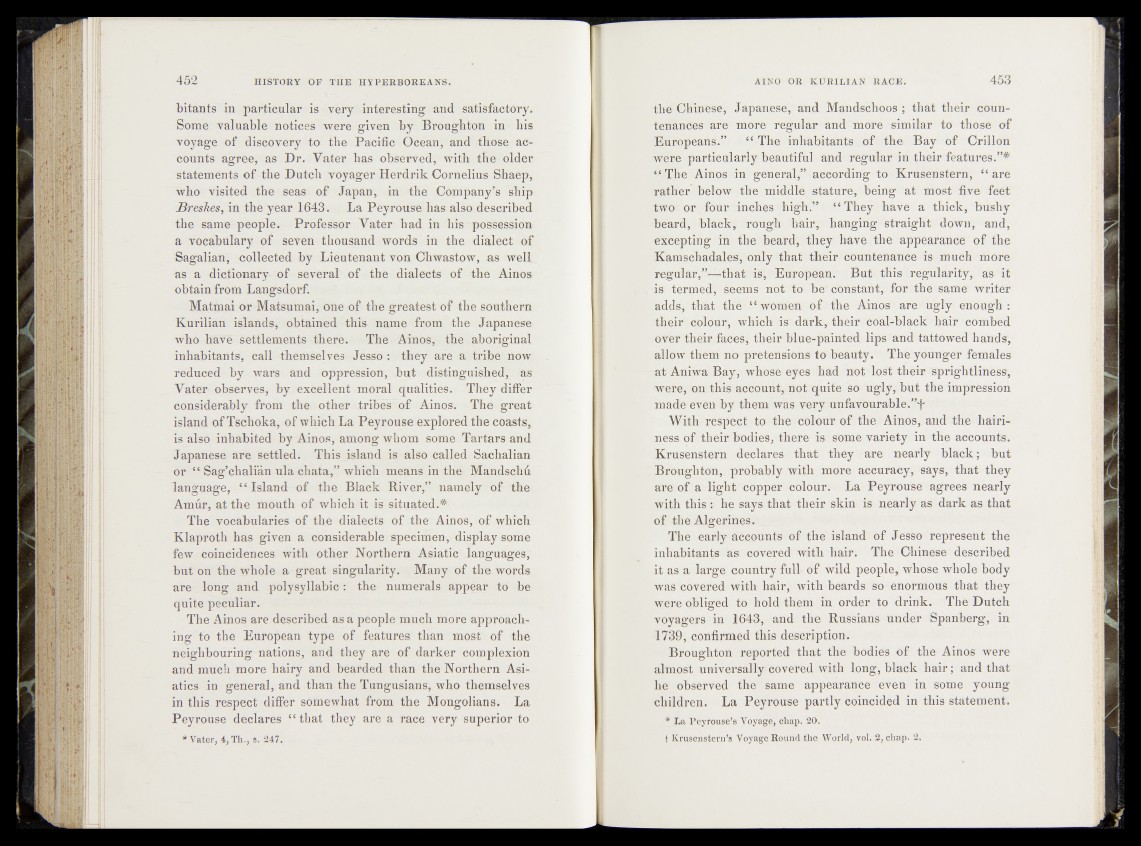
bitants in particular is very interesting and satisfactory.
Some valuable notices- were given by Broughton his
voyage of discovery to the Pacific Ocean, and those accounts
agree, as Dr. Vater has observed,'with the older
statements of the Dutch voyager Ilerdrik Cornelius Shaep,
who visited the seas of Japan, in the Company’s ship
Breskes, in the year 1643. La Peyrouse has also described
the same people. Professor Vater had in his~possession
a vocabulary of seven thousand words in the dialect of
Sagalian, collected by Lieutenant von Chwastow, as well,,
as a dictionary* of several of the dialects of the Ainos
obtain from Langsdorf.
Matmai or Matsumai, one of the greatest of the southern
Kurilian islands, obtained this name from the Japanese
who have settlements there. The AiHos^ the aboriginal
inhabitants, call themselves JessO: they are a tribe now.
reduced by wars and oppression, hut distinguished, as
Vater observes, by excellent moral qualities^ They differ'
considerably from the other tribes" of Ainos-. The great
island of Tschoka, of which La Peyrouse^explored the coasts,
is also inhabited by Ainos, among whom some Tartars and
Japanese are settled. This island is also called Saehalian
or “ Sag’chalian ula ehata,” which means in the Mandschu
language, “ Island-of the Black River,” namely-of- the-,
Amur, at the mouth of which it is situated.*
£ The vocabularies of the dialects of the Ainos, which
Klaproth has given a considerable specimen, display some
few coincidences with other Northern Asiatic languages,
but on the whole a great singularity. Many of the words
are long and polysyllabic: the numerals appear to be
quite peculiar.
The Ainos are described as a people much more approach-?
ing to the European type of features than most of the
neighbouring-nations, and they are of darker complexion
and much more hairy and bearded than the Northern Asiatics
in general, and than the Tungusians, who themselves
in this respect differ somewhat from the Mongolians. La
Peyrouse declares “ that they are a race very superior to
| Vater, 4, Th., s. 247.
the Chinese, Japanese, and Mandschoos; that their countenances
are mOr'e regular and more similar to those of
Europeans.” “ The inhabitants vhf the Bay of Crillon
were - particularly beautiful and regular in their features.”*
“ The Ainos in general,” according to Krusenstern, “ are
rather* below the middle stature, being at most five feet
two o r, four inches''-high'.!^ “ They'have a thick, bushy
beard, black, rough- baii^éhanging 'straight down, and,
excepting in the beardipthey have the appearance of the
Kamschadales, only that their countenance is much more
regular,”—that ,!-iS;, European. But this regularity, as it
is termed, seems Hbt to’ blf constant, for the same writer
adds, that the “ women of ê the?-Ainos *--are tf'ugly enough:
their colour, which is dark, them coal-black hair combed
ov4r their* faces,» their bluef-pRinted; lips an##attewed hands,
allow them no pretensions^ to beauty. The younger females
^at Aniwa Bay, whOsé-Cyes had Hot' lost their Sprightliness,
were, on this account, not quite- so ugly, but the impression
mad<eteveH by them was very unfavourable.’^
Witte'reSpect- to th e r^ lo u r of the Ainos, and the hairiness
of their bodies, there is- some variety sM the accounts.
Krusenstern declares thatethey are nearly black; but
Broughton,, probably with more accuracy, says, that they
are of a light copper colour. La Peyrouse agrees nearly
with thisï he says that them skin is* nearly as dark as that
of the Algerines. _
The early accounts of the island of JessO represent the
inhabitants as covered with hair.: -The Chinese described
it as a large country fuik of wild people, whose whole body
was covered with hair,- with beards so enormous that they
were qbliged to hold them in order -to drink. The Dutch
voyagers in 1643, and the Russians under Spanberg, in
1739, confirmed this description.
Broughton reported that the bodies of the Ainos were
almost universally’covered, with*Jong, black hair; and that
he observed the same appearance even in some young
children. La Peyrojlsfe partly coincided in this statement.
* La Peyrouse’s Voyage, chap. 2Ö.
t Krusenstern’s Voyage Round the World, vol. 2, chap. 2.